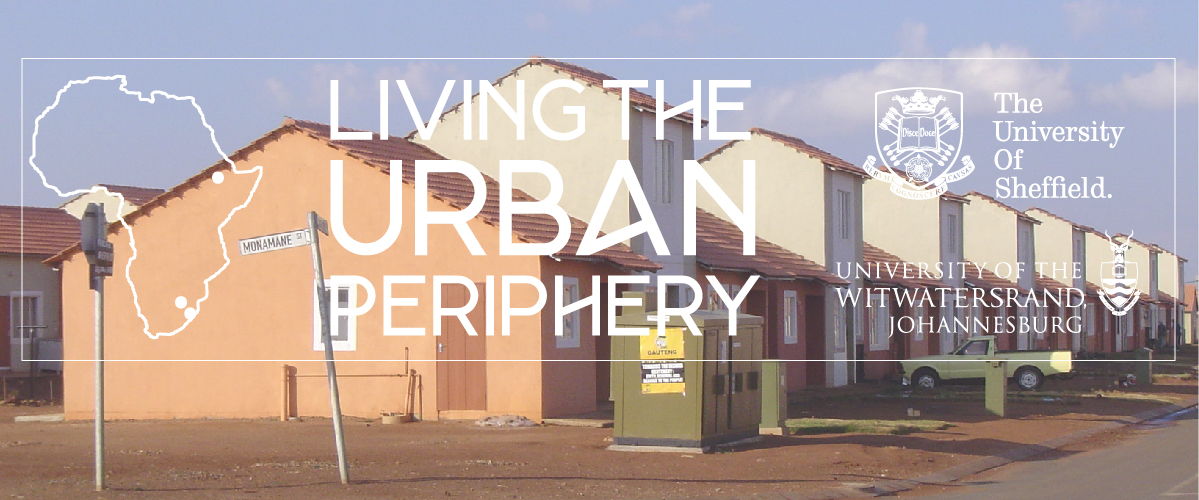
WESTERN JOHANNESBURG: LUFHERENG, PROTEA GLEN AND WATERWORKS

Located to the west of Soweto, one of Johannesburg’s historic apartheid townships, Lufhereng hosts Johannesburg’s so-called biggest integrated development, currently under construction. This state-led greenfields development, which broke ground in 2008, is expected to accommodate at least 22,500 households on 2,080 hectares by 2023. The plans for the mixed-income development include ‘RDP’ fully state-subsidised housing for the poor; provision for social housing; and a portion of units available on the market. There are intentions to cultivate an economic base in the area, which is currently primarily residential. In addition to the plan to create an industrial hub, the City of Johannesburg and Gauteng Province plan to encourage agriculture-related activities in the area.
The area is peripheral to the City of Johannesburg metropole, sitting on the edge of its municipal boundary. However, its location is considerably less peripheral when looking at the broader Gauteng City-Region. As a case study, it provided a welcome conceptual challenge to the idea of the urban periphery.
Lufhereng’s economic development plan describes it as being in ‘the central portion of the Gauteng Province… in the general vicinity of the Roodepoort and Lenasia nodes’ (Urban Econ 2014: 2). It is argued by its private-sector consultants and by provincial planners to be a ‘natural extension’ of Soweto: a future growth area, because of the availability of land and the ‘natural flow of the urban sprawl of Soweto’ (Urban Econ 2014: 25). [...] Yet from a City of Johannesburg planning perspective the area has long fallen outside of its public transport investment corridors, been seen as spatially peripheral and a low priority investment area as it fell outside the City’s urban development boundary (Ahmad 2010). Ahmad (2010: 22) refers to Lufhereng as one of a number of projects that produce large numbers of houses, in relatively straightforward contractual circumstances and on comparatively lower cost land, but contends that from a spatial perspective these projects ‘reinforce the challenges of marginal access to jobs, amenities and public transport’. - Charlton (2017)
Protea Glen, an adjacent middle class suburb with multiple extensions provides an interesting point of comparison with Lufhereng. To the south of Protea Glen is the small Waterworks informal settlement, also located alongside the R554 road that runs adjacent to Protea Glen and Lufhereng but situated on the Rand West side of the municipal border.
The wider area is receiving further attention from the Gauteng provincial government, with the planned Syferfontein mega human settlement south of Lufhereng in the neighbouring municipality. Overall, the area provides an interesting case of state-investment and mixed-income housing in both an established and new area, in an ambiguously peripheral location.
Our study in 2017 and 2018 found that residents of Lufhereng and Protea Glen had a more positive outlook of the changes they had experienced than those from Waterworks who were largely unhappy. In Protea Glen new shopping centers, Rea Vaya buses and WiFi were all welcomed. In addition to their housing, Lufhereng residents appreciated electricity and streetlights but noted that the lack of trains, buses and shopping centres created difficulties. In the Waterworks informal settlement very poor sanitation, water supply and refuse services have fuelled frustration. Across all three areas employment opportunities are perceived to be far away and the cost of transport prohibitive. Residents of Lufhereng noted better access to jobs in the informal settlement they lived in previously, while available work for Waterworks residents was generally very low-paid, part-time or insecure. Crime, alcohol and drug abuse are seen as serious problems in all three areas, and residents call for recreation and sports facilities for youth. While Protea Glen has its own police station, Waterworks’ location on the far side of the municipal boundary has meant distant police services from Rand West municipality. Starting in 2018, qualifying residents were being relocated deeper in to the municipality due to proposed commercial development on private land at Waterworks. Arrangements for residents not qualifying for government housing subsidy were unclear.
A summary of key findings for this area can be found in the Lufhereng, Protea Glen and Waterworks pamphlet (English) or Ekangala and Rethabiseng pamphlet (isiZulu).

